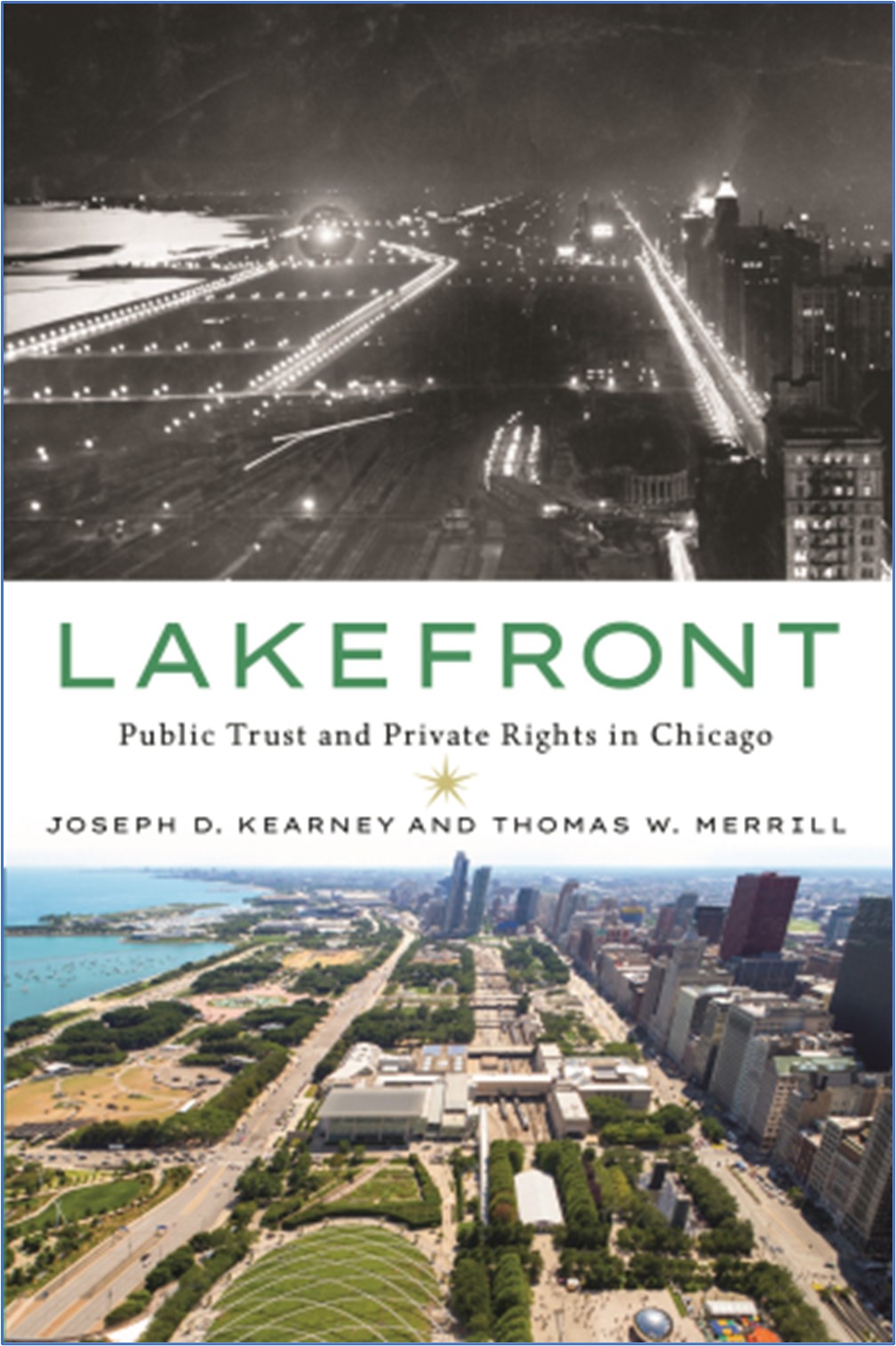“Urbs in Horto”— city in a garden—is the motto Chicago’s founders chose upon the city’s incorporation on March 4, 1837. At the time, this was more of a vision than a statement of fact, as the city had few public parks then, and preserving its existing open spaces seemed uncertain at best. Given the industrial waterfronts in many other large cities, it is a marvel that  Chicagoans made that early vision a reality, at least along the water, by creating the city’s magnificent lakefront parks and protecting open space over nearly two centuries. How did it happen, and what are the lessons for urban development more generally? The definitive account is provided in Lakefront, a remarkable new book twenty years in the making, coauthored by Marquette Law School Dean (and Chicago native) Joseph D. Kearney and Columbia University’s Thomas W. Merrill.
Chicagoans made that early vision a reality, at least along the water, by creating the city’s magnificent lakefront parks and protecting open space over nearly two centuries. How did it happen, and what are the lessons for urban development more generally? The definitive account is provided in Lakefront, a remarkable new book twenty years in the making, coauthored by Marquette Law School Dean (and Chicago native) Joseph D. Kearney and Columbia University’s Thomas W. Merrill.
Lakefront is, at its core, a story about Chicago and the development of its world-renowned lakefront. But Kearney and Merrill also make a significant contribution in untangling the American development of the public trust doctrine, which has been called “unquestionably one of the most important elements of U.S. natural resources law.”[1] The Supreme Court has recognized the doctrine’s ancient origin and its roots in Roman law.[2] Scholars have traced it to the Code of Justinian. Today the doctrine is generally thought to protect and preserve certain natural resources of a “special character,” through a perpetual trust intended to prevent the unimpeded exercise of private rights upon them. But clarifying the doctrine’s operational reach has proven difficult, and it has evolved into many different strains of varying strength primarily governed by state common law. However, all agree that Justice Stephen Field’s 1892 opinion for the U.S. Supreme Court in Illinois Central Railroad Co. v. Illinois was the moment at which the doctrine became a prominent feature of American law. Lakefront provides groundbreaking new details and a blow-by-blow account of how the case originated from the battles between public and private rights on the Chicago lakefront.
In what comes as something of a surprise, though, Kearney and Merrill’s account shows that despite the relative fame of the public trust doctrine, a different, more obscure legal rule—the public dedication doctrine—provided much of the early impetus for the lakefront’s preservation. Under the public dedication doctrine, owners of private property can exercise a right to block development on adjacent public lands, when the development would deviate from the original dedication. In uncovering this story, the authors provide an interesting direction for future research—what is, or was, the relative reach of the two doctrines in other American cities that did (or did not) manage to preserve publicly owned waterfront property? The authors suggest that if the public trust doctrine is to serve as an effective preservation tool, it is in dire need of clarification in some states—even Illinois (the place of its American origin). Control of waterfront property will always be controversial, and as more cities develop, the fate of some of the most desirable land in the nation hangs in the balance.
Aside from these important doctrinal aspects of the book, Kearney and Merrill recount the fascinating history of the lakefront in well-researched detail. The book traces the footsteps of the giants who walked the landscape and—intentionally or not—helped to preserve it. These include Aaron Montgomery Ward, the commercial magnate nicknamed the “watchdog of the lakefront,” who skillfully employed the public dedication doctrine—among other legal maneuvers—to block the construction of buildings in Grant Park. And while many of the story’s key players draw from Chicago’s elite, the authors also describe the “struggle for Streeterville,” the neighborhood north of the Chicago River. They write that it “included everything from a gun battle involving the followers of George Wellington Streeter, a notorious squatter, to a conspiracy to secure the land by using scrip given by Congress to the survivors of a Mexican-American War hero, to an attempt to claim the land for a branch of the Potawatomi Indians.”
Engineers and environmentalists alike will be interested in a chapter devoted to reversing the Chicago River. Doing so diverted Chicago’s wastewater discharges away from the lakefront and routed them across the subcontinental divide to the Mississippi River watershed. This infuriated the people of St. Louis, who were on the receiving end. Today the effort is regarded simultaneously as an engineering marvel and an environmental catastrophe. Lakefront relates the project’s many twists and turns, from its origin to “shovel day” to the final showdown with Missouri in the Supreme Court.
And the book covers much, much more: Lincoln Park. Lake Shore Drive. The Art Institute. Millennium Park. The echoes of these foundational struggles resound today in disagreements over the potential lakefront sites for the failed Lucas Museum project and the thus-far successful Obama Presidential Center project.
“Urbs in Horto” still appears on Chicago’s corporate seal, and today’s Chicagoans can treasure its fulfillment, at least along the lakefront. While many may not realize it, the story is also central to the development of the public trust doctrine, a critical feature of environmental law today. Lakefront tells the tale.
More coverage: This flyer contains more detail on the book. It has also been discussed in the Marquette Lawyer magazine, by Columbia Law School, and in academic blogs. Kearney and Merrill wrote an op-ed in the Chicago Tribune arguing against making the lakefront a national park and also provided an interview to WGN radio (interview link courtesy of Steve Bertrand/WGN Radio).
[1] John D. Echeverria, The Public Trust Doctrine as a Background Principle in Takings Litigation, 45 U.C. Davis L. Rev. 931, 950 (2012)
[2] PPL Montana, LLC v. Montana, 565 U.S. 576, 603 (2012).

